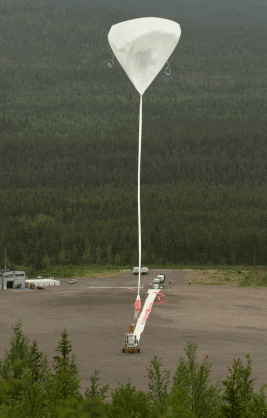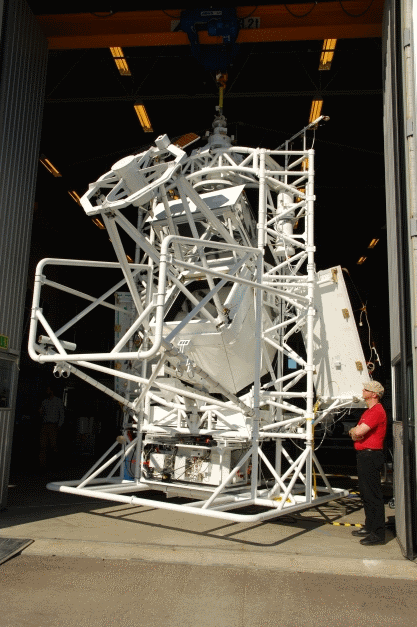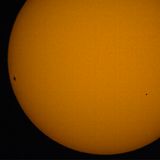
By Tammy Plotner
Observing the Sun with Balloons
Is there anything more exciting than watching a release of helium balloons? Isn't it majestic to witness a hot air balloon sail across the sky? If you love sights like these, then you'll be fascinated by one of the latest methods to study our nearest star... the SUNRISE Mission.

Caption: The balloon rises into the sky. Only when it is positioned exactly above the solar observatory, will the launching vehicle release its load. (Credits: MPS)
SUNRISE is a solar observatory that was conceived less than a decade ago by an international team of scientists. A helium-filled balloon carries the largest solar telescope to leave the Earth up to a height of 37 kilometers. When it reaches that lofty range of about 27 miles above our heads, the balloon expands to about 130 meters in size - or about 430 feet in diameter.
As it cruises the upper atmosphere, to a float altitude of 120,000 feet, it will have left all but 5% of Earth's atmosphere beneath it, allowing the instrumentation to function without the degrading affects on observing produced by the lower levels. From this vantage point, SUNRISE can watch the Sun with unprecedented clarity... viewing surface details and recording the distribution of magnetic fields with a resolution of up to 35 kilometers. That's like being able to spot details on a coin from a distance of nearly 63 miles away!
"Turbulence in the atmosphere inevitably blurs all images of ground-based telescopes," explains Dr. Peter Barthol from Max Planck Institute for Solar System Research (MPS) in Germany, SUNRISE project manager.
Once the observatory reaches its travelling height, the Earth's polar winds will embrace the balloon and gondola and carry them westward around the North Pole.
"Thanks to the midnight Sun in these latitudes north of the Arctic Circle, we will be able to look at the Sun nonstop," says Barthol.
Four years ago, SUNRISE embarked on its first, six-day journey and delivered the most detailed images of the Sun up to that date. Unfortunately, the Sun was "quiet" at the time, displaying very little activity.
Now, after two months of preparation, SUNRISE is sailing again.
"SUNRISE's first mission showed us, that this ambitious concept works", says Prof. Dr. Sami K. Solanki, director at the MPS and scientific head of the mission.

Caption: The white gondola carries the telescope and additional scientific instruments. (Credits: MPS, P. Barthol)
At around 2 a.m. CEST on June 12, 2013, the huge launching vehicle picked up SUNRISE from the large experimental hall at the Max Planck Institute for Solar System Research, which had been storing the solar observatory in the last two months, and brought it to the launch pad.
"The weather conditions are decisive for launching", says Solanki. "SUNRISE can only safely reach its travelling height, if the winds in the air layers below blow only very lightly. This is especially important on the first few kilometers."
After four or five days, the observatory could travel as far as the north of Canada, where it will land with the help of a parachute. As it sails along, the researchers plan on using every second of time to devote SUNRISE's sensitive instruments to gathering data. Perhaps it will be able to shed some proverbial light upon some of the greatest mysteries in solar physics, such as why the Sun's activity changes in an approximately eleven-year-cycle or why the outermost layer of the Sun, the corona, is approximately 500 times as hot as the photosphere below.
"Four years ago, the Sun showed us quite impressively, that this eleven-year-cycle is just a rough rule of thumb", says Solanki.
Will SUNRISE provide us with all the expected results? Although it will be months before the solar physicists are able to sift through all the information it gathers on this latest mission, the researchers are optimistic that the incredible balloon with its unique payload will give back great return. The first time the solar observatory was launched, the Sun didn't cooperate, but solar maximum is underway and the team is hopeful.
"For the second mission, this should be quite different," says Barthol.
Watch the SUNRISE ballon in real time here: http://www.csbf.nasa.gov/sweden/sweden.htm
Tammy Plotner is a professional astronomy author, President Emeritus of Warren Rupp Observatory and retired Astronomical League Executive Secretary. She's received a vast number of astronomy achievement and observing awards, including the Great Lakes Astronomy Achievement Award, RG Wright Service Award and the first woman astronomer to achieve Comet Hunter's Gold Status.



















